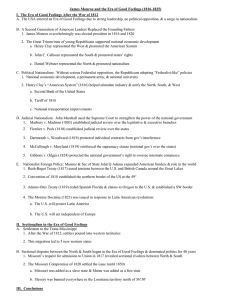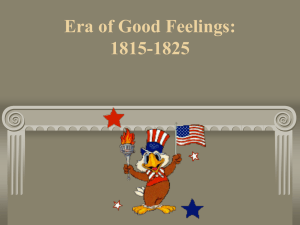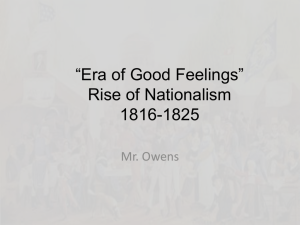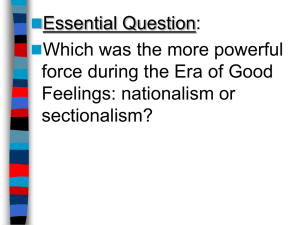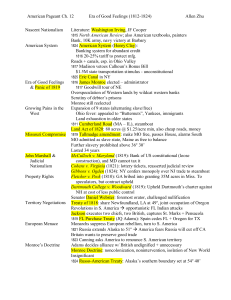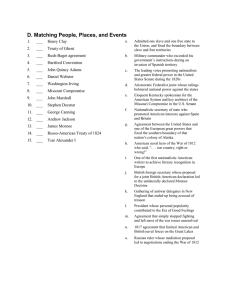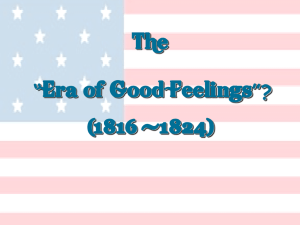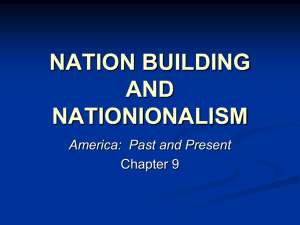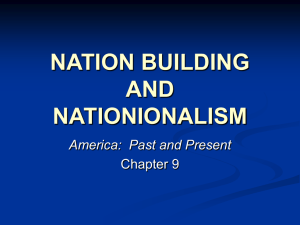Document 17596022
advertisement
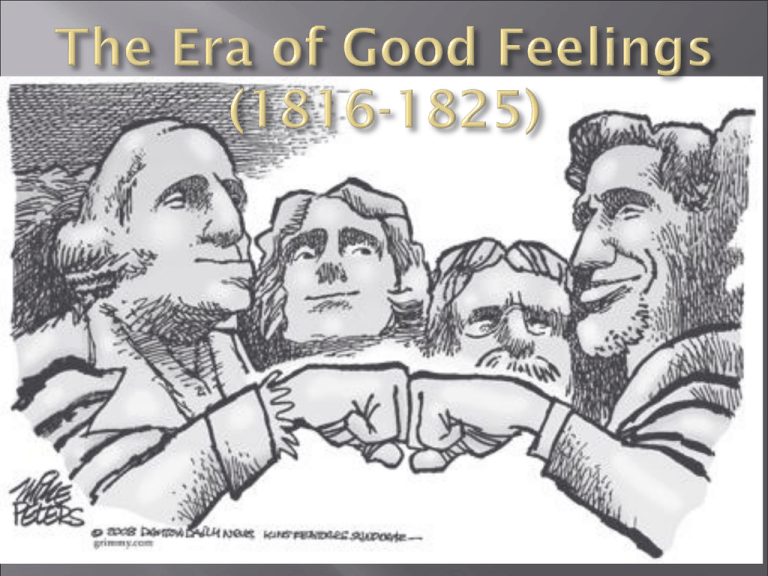
After the War of 1812, America experienced an “Era of Good Feelings” characterized by: An extremely popular president The emergence of a 2nd generation of U.S. leaders Dominance by the Republicans A surge in nationalism that united the country & improved U.S. industry & transportation He appointed Democrats, Federalists, James Monroe was elected Southerners, Northerners to his cabinet; president in 1816 & 1820 with a including Sec of State John Q Adams clear set of goals: To promote national unity To promote America’s power in the world Republican dominance of the presidency & Congress helped push through a series of new laws By 1816, a wave of new leaders shaped the antebellum era: Henry Clay (Republican, KY) : Represented the “West” Speaker of the House Proponent of national economic development (“American System" to promote industry & markets for farmers) By 1816, a new wave of leaders shaped the antebellum era: John C. Calhoun (Republican, SC): Represented the “South” Sec of War; VP He was the nation's leading proponent of states' rights embraced nullification By 1816, a new wave of leaders While they did not always agree, this shaped the antebellum era: “Great Triumvirate” of Clay, Calhoun, & Daniel Webster (Whig, MA): Webster enthusiastically supported national Represented the “North” economic development Congressman; Sec of State Strong proponent of Nationalism & strong critic of states' rights The Dem-Repubs traditionally represented limited gov’t, states' rights, & strict construction But, without Federalist opposition, the Dem-Repubs adopted many traditionally Federalist policies: National economic development A permanent army Transportation improvements A national university in D.C. All were proposed bylet Hamilton & of 1st significant Jefferson the charter opposed the 1790s protective tariffby Republicans the 1st BUS in expire in 1811 in U.S. historyClay’s American System Henry in 1816 proposed the creation of: The 2nd Bank of the U.S. to stabilize U.S. currency Helped the way for futureU.S. RR Tariffpave of 1816 to promote construction Indian removal of industry&&western limit the importation British manufactured goods A nat’l system of roads & canals The “American System” helped unify North, South, & West John Marshall (1801-1835) used the Supreme Court to strengthen the power of the national gov’t: Exerted the power of the national gov’t over the states Rejected the claim that states could check powers of the national gov’ t Affirmed the loose construction argument of the elastic clause Dartmouth v. Woodward (1819): gov’t cannot interfere with contracts between private parties McCullough v. Maryland (1819): Congress possesses powers not explicitly stated in Constitution; Congressional laws are supreme to decisions made by the states Gibbons v. Odgen (1824): interstate commerce is power reserved for national gov’t President Monroe & Sec of State JQ Adams developed a nationalist foreign policy agenda The Convention of 1818 set the US/Canada Treaty border (1817): set at theto49º Rush-Bagot avoid conflicts along the Great Lakes, the U.S. agreed not to take Canada & Britain not to invade the U.S Monroe & JQ Adams turned their attention to assumed acquiring Also, Spain Florida Florida:would eventually be annexed Andrew Jackson took$5 it upon U.S. agreed to pay Spain million himself to end claims Indiantoattacks & renounced Texas on Georgia from Spanish Florida Jackson’s military advances & U.S. success in the War of 1812 helped force the Adams-Onis Treaty (1819) that ceded Florida & Oregon to U.S. The U.S. will protect Latin Whenindependence Latin American nations American revolted against Spain, the U.S. The U.S. will act independently & supported theitsnew republics: will protect sphere of influence European powers disliked these liberal rebellions & were tempted to re-conquer them Monroe Doctrine (1823) warned European nations to stay out of the Western Hemisphere & the U.S. will not interfere in Europe The end of the War of 1812 unleashed a rush of pioneers into the western territories Many settled in the West to escape overpopulation, rising land prices, & worn-out soil in the East The 2nd BUS made credit available for farmers to purchase land By 1810, 1/7th of the U.S. population lived in rd lived in the West the West; By 1840 over 1/3 Congress quickly admitted 5 states to the Union: Indiana (1816) Illinois (1818) Alabama (1819) Mississippi (1817) Louisiana (1812) The Era of Good Feelings started with a wave of national unity, but sectional disputes between the North & South emerged & would dominate politics for next 40 years Disagreed over the use of protective tariffs, especially when cotton prices fell in 1820s Disagreed over slavery in the western territories & states Population was growing more rapidly in North, so House of Reps favored Northerners In 1817, Missouri applied for statehood as a slave state & NY rep Tallmadge wanted rivalries: Missouri revealed U.S. sectional only if its state constitution provided for North resented Southern control of the gradual elimination of slavery presidency & its 3/5-inflated representation in House of Reps South feared a Northern conspiracy to end all slavery Equality had been maintained by alternating admission of “free” & “slave” states added to the US Missouri Compromise (1820): Missouri became a slave state Maine (which broke from Mass) was admitted as free state Slavery was banned elsewhere in the Louisiana Purchase above the latitude of 36°30' The Missouri controversy exposed a deep rift between North & South The “Era of Good Feelings” led to: An improved American economy Better transportation More territory & more clearlydefined borders A foreign policy in Latin America But…sectional problems between the North & South Both Alexander Hamilton & John Marshall were Federalists who believed in a strong national gov’t. Who was more influential in shaping American history? Explain Which policy will be more important in U.S. history: Monroe’s foreign OR domestic policy? Essential Question: How did U.S. foreign policy change from the presidencies of Washington to Monroe? RQ Ch 10B (328-340)
